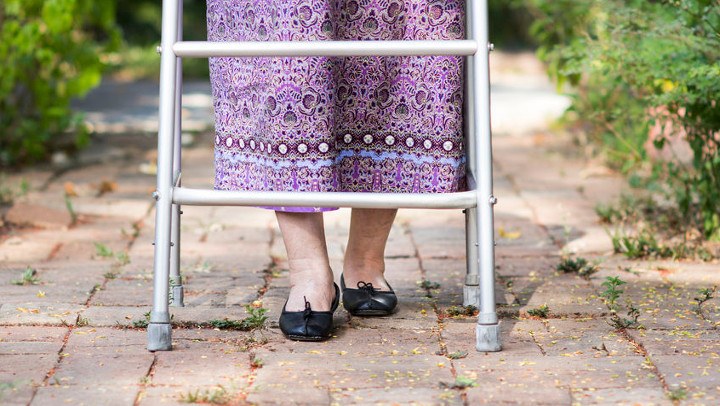Do you find yourself holding your breath as your dad or mom shuffles across the floor, daring to exhale only after he or she is finally settled into a chair?
That shuffling gait, so common in older adults, can be caused by many things, including Alzheimer’s and Parkinson’s disease. What happens, due to a combination of neurological, muscular and balance impairments, is that it becomes more difficult to lift the legs and feet high enough to clear even the smallest obstacle, such as the edge of a carpet. The result? A shuffle. And, a perfect storm for a fall.
Below are four key areas that typically hinder gait, with some tips to keep muscles, vision and balance as strong as possible, for as long as possible.
- Weak leg and foot muscles
What you can do: In addition to leg lifts and calf raises, therapists recommend the following: line up four 15” long 2x4 wood blocks, about two feet apart, and mark them with bright colored tape so that they are easily seen. Have your loved one step slowly over each block until they reach the end; then back again. This exercise builds awareness, as well as improved strength and balance.
- Loss of flexibility in feet
What you can do: Stretching exercises, such as pointing and flexing the feet, especially in the morning before rising, can help increase flexibility. Yoga and other slow, sustained movements help as well.
- Poor balance
What you can do: Try “eye tracking”. Move your thumb in front of your loved one’s face and have them follow it with their eyes. Gradually move the thumb further out. Finally, have them move their head to follow each movement. Other good balance exercises are calf raises and shifting from one leg to another. (Be sure to have a walker or a sturdy chair handy for them to hold on to.)
- Impaired vision
What you can do: Regular eye exams are key to identifying and treating diseases such as macular degeneration, glaucoma and cataracts; all of which impair vision. Make sure eyeglass prescriptions are up to date as well.
Of course your loved one’s physical environment should be safeguarded as well. Clear pathways of obstacles and install handrails where needed. Make sure stairways, halls and bathrooms are well lit. And make sure his or her footwear fits properly.
Remember that your loved one wants to remain mobile for as long as possible. But the last thing either of you wants is a fall. Together, you can help reduce the risk of a fall, while keeping them as strong as possible, for as long as possible. That’s worth working for.
Since 2009,
Anthem Memory Care has been a haven for loved ones who need memory and dementia care. Our experienced, professional team expands over 20 communities with more than 1,300 suites designed for memory care needs. Each community offers numerous helpful amenities and resources, creating a nurturing and supportive environment that caters to the needs of our residents. Along with compassionate and personalized
memory care, we provide services in areas of wellness, health, and safety. We invite you to explore our services or contact us today if you have any questions.
